第二讲 翻译
- 格式:ppt
- 大小:614.00 KB
- 文档页数:36
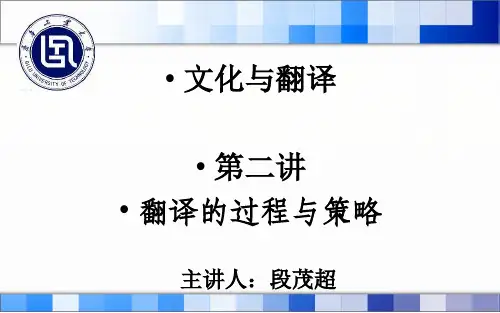

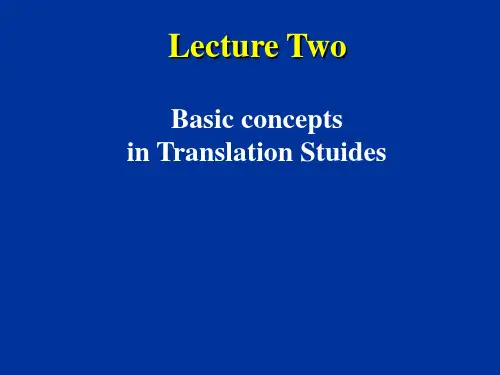
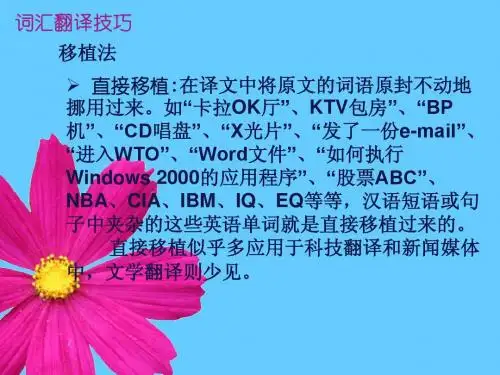
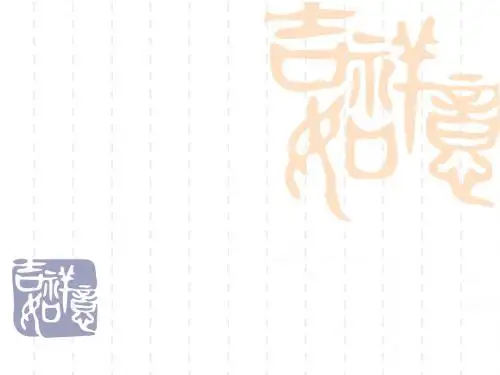
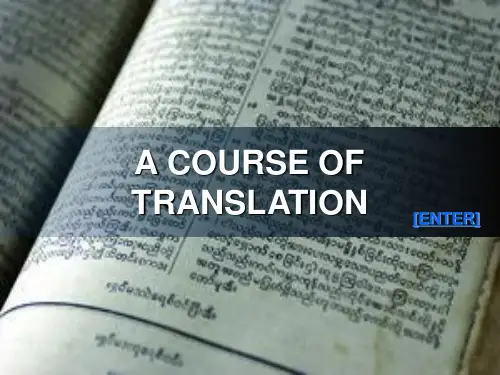

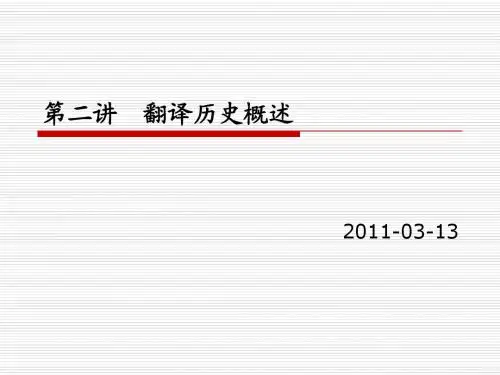

第二讲 A Psalm of Life鉴赏·相关背景·亨利·沃兹渥斯·朗费罗,1807-1882,美国诗人。
《人生礼赞》这首诗写于1838年,很快成为一首极富盛名的诗篇。
此诗长达9节,以四步抑扬格写成。
它是一首训教诗,哲理深刻,作者感叹生活的艰辛,劝勉人们要坚韧不拔,不要气馁,要振作,要奋斗,要有所追求,要有所作为,从而使人生的小舟在经过风暴的洗礼之后抵达理想的彼岸。
《人生礼赞》这首诗自发表以来一直广为传诵,直到2000年还被当年的美国桂冠诗人与他人经广泛调查后选定,编入《美国人喜爱的诗》。
本诗还是第一首被译为汉语的欧美诗歌,最早的译文距今已一百多年,赢得了无数中国读者的心。
"A Psalm of Life" is a poem written by American writer Henry Wadsworth Longfellow and was published in October of 1838. It is a poem of encouragement, telling the reader not to waste life. Longfellow is sure to establish that life is real, and it will end soon. He wrote this poem at a fairly young age, yet he has a deep and accurate insight of life.The content of the poem is not especially unique. The speaker is involved in the first person perspective, where he is directly addressing the reader. The tone is neither positive nor negative, but is strictly honest. The tone remains the same "encouraging" style from beginning to end, and there is no change of tone. The only tension found in the poem is that between life and death - Longfellow writes about how every living thing is affected by both conflicting states of being.The word choice in "A Psalm of Life" was obviously carefully picked. An adjective is never repeated, yet the poem reads perfectly. Each word has its own meaning, and its own unique take on life, and every word adds something important, even vital, to the "life" of the poem. The rhythm also flows flawlessly. The rhythm scheme is an eight syllable line followed by a seven syllable line. The poem does not stray from that simple rhythm once.Imagery is the sole method of expression in the poem. Longfellow paints a word picture in each stanza that allows the reader to see more clearly what he is describing. Metaphors and Symbolism is rampant - in fact, the poem is almost entirely comprised of these things.The form of the poem is very basic. Each stanza is four lines long, making the poem a quatrain, and the rhyme scheme follows the pattern "ABAB, CDCD, EFEF..." etc. for each of the nine stanzas. Each stanza also has a recurrent rhythm pattern: 8 syllables, 7 syllables, 8 syllables, 7 syllables. Analyzing the poem even deeper, you will notice that even the punctuation plays an important role. Exclamation points are used to establish emphasis on a particular line. There is no pattern to the punctuation, which makes it even more beneficial to strengthening the meaning of a phrase. Overall, it is very obvious that "A Psalm of Life" is a well thought out poem.词语注解:Psalm:The Book of Psalms, commonly referred to simply as Psalms, is a book of the Hebrew Bible and the Christian Bible. Taken together, its 150 poems express virtually the full range of Israel'sreligious faith. 《诗篇》(《圣经·旧约》中的一卷。
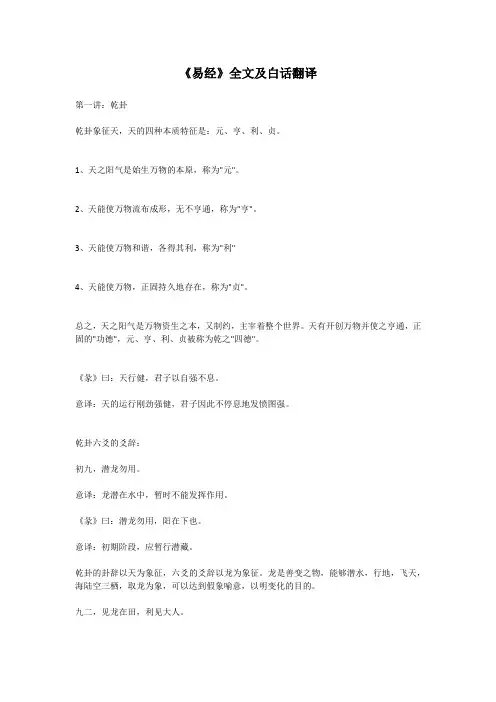
《易经》全文及白话翻译第一讲:乾卦乾卦象征天,天的四种本质特征是:元、亨、利、贞。
1、天之阳气是始生万物的本原,称为"元"。
2、天能使万物流布成形,无不亨通,称为"亨"。
3、天能使万物和谐,各得其利,称为"利"4、天能使万物,正固持久地存在,称为"贞"。
总之,天之阳气是万物资生之本,又制约,主宰着整个世界。
天有开创万物并使之亨通,正固的"功德",元、亨、利、贞被称为乾之"四德"。
《彖》曰:天行健,君子以自强不息。
意译:天的运行刚劲强健,君子因此不停息地发愤图强。
乾卦六爻的爻辞:初九,潜龙勿用。
意译:龙潜在水中,暂时不能发挥作用。
《彖》曰:潜龙勿用,阳在下也。
意译:初期阶段,应暂行潜藏。
乾卦的卦辞以天为象征,六爻的爻辞以龙为象征。
龙是善变之物,能够潜水,行地,飞天,海陆空三栖,取龙为象,可以达到假象喻意,以明变化的目的。
九二,见龙在田,利见大人。
意译:龙出现在田间,有利于大德大才之人出现。
九三,君子终日乾乾,夕惕若,厉无咎。
乾乾:健行不息。
若:语助词。
厉:危险。
意译:君子整天勤奋不息,甚至夜间时时警惕,虽然面临危险也无祸害。
九四,或跃在渊,无咎。
意译:相机而动,跃起上进,无咎害。
九五,飞龙在天,利见大人。
意译:飞龙上天,有利大德大才之人出现。
九五在所有卦里都是最吉之爻,此爻为"君位"。
皇帝通称"九五之尊",就是这么来的。
乾卦九五,刚健中正,纯粹而精,最为可贵。
上九,亢龙有悔。
意译:龙高飞到了极点,必有过悔。
用九,见群龙无首,吉。
意译:出现一群龙,都不以首领自居,吉祥。
常用占断用语:1、亨:通达,顺利。
2、利:有利,适宜。
3、吝:遗憾,麻烦,艰难。
4、厉:危险。
5、悔:忧虑,困厄。
6、咎:过错。
第二讲坤卦坤:元亨,利牝马之贞,君子有攸往,先迷,后得主,利。
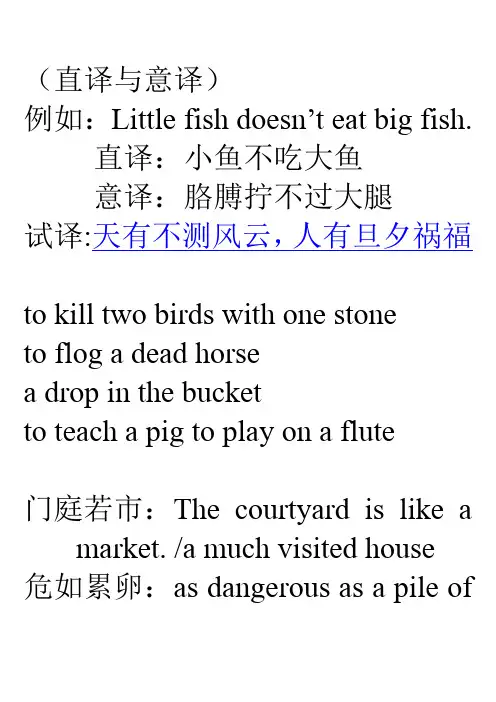
(直译与意译)例如:Little fish doesn’t eat big fish.直译:小鱼不吃大鱼意译:胳膊拧不过大腿试译:天有不测风云,人有旦夕祸福to kill two birds with one stoneto flog a dead horsea drop in the bucketto teach a pig to play on a flute门庭若市:The courtyard is like a market. /a much visited house危如累卵:as dangerous as a pile ofeggs/great insecurity; hazardousin the extreme由于文化对语言的影响,有些语言成分只能意译,而不能直译,这主要体现在受本国文化影响最深的成语和谚语上。
hand in glove with:和...狼狈为奸once in a blue moon: 千载难逢乱七八糟:at sixes and sevens (seven disorders and eight chaos)招风惹草:look for trouble (invite wind to exasperate the grass)It is an ill bird that fouls its own nest.外甥打灯笼---照舅(旧)归化与异化(domestication/adaptation orforeignization / alienation)归化的翻译在理论上是把语言看作交际工具;在实践上,强调通俗易懂,避免多义或歧义。
习惯认为,当原文与译文之间因文化差异而出现不能通达的情况时,“要用译语文化替代原语文化”即把在译语中找不到对等的外语词汇改头换面,或套用译语中与之相似的现成的表达法,把它们变成读者熟悉的译语文化形象。
归化派代表人物尤金•奈达(Eugene A. Nida): Functional Equivalence 功能对等“The receptors of the translated text could respond to it with comprehension and appreciation in essentially the samemanner and to the same degree as the original receptors of the message”;“Translation should arouse the same feeling in its receptors as the feeling of the readers of the original”---- NidaFor instance: as white as snow 通常译为白如雪/ 但没有见过雪的人可以将其翻译为“白如白鹭毛”,以达到功能对等的目的。
第二讲英汉词义对比与翻译中根据语境选词一、语境与意义的关系概述词是语言中能自由运用的音义结合体,是构成句子的最基本的单位,所以词的意义直接影响读者对句子甚至对整个篇章的理解。
虽然在翻译的过程中一般以句子为翻译单位,但如果不能把词的意思准确地翻译出来,势必会影响到对整个句子甚至对整个篇章的翻译。
由此可见词在翻译中的重要性。
在选词时,我们除了要注意词的基本含义(概念意义)外,也要明白翻译中的选词更多地受到诸多因素的影响。
语境可分为¡°微观语境(Microcontext)¡±和¡°宏观语境(Macrocontext)¡±,前者主要指词的搭配,包括词组、分句、句、句段、文本或篇章、体裁;后者指非语言因素,即社会、文化、历史因素。
同一个词,在不同的语境中,其涵义、词义广狭、感情色彩、文体色彩、文化色彩等不尽相同。
语境决定词的涵义、词义的广狭、词的感情色彩和语体色彩以及文化涵义等。
翻译时必须将语境纳入考虑之中,仔细斟酌,才能真正取得好的翻译效果。
⏹长期以来,中国学生在学习英语的过程中,尤其在学习英语单词的过程中总喜欢通过其汉语意思记忆单词,久而久之,就形成了一种“怪圈”,即一个英语单词对应一个中文意思(一个汉语词),翻译的时候,往往就会将英语单词与汉语词一一对应起来,结果造成翻译中用词不当的现象。
或者,有时在翻译中遇到不知该如何在目的语中进行表达,只靠单纯地查阅英汉词典或汉英词典,结果发现,英语的汉译文不够通顺,搭配不当,汉语的英译文就让人感觉词不达意。
实际上,英语单词与汉语词并非一一对应的关系,而应根据词所在的语境决定词在上下文中的涵义、词义的广狭、词的感情色彩词、词的语体色彩、词的联想意义等,然后根据这些意义在目的与中选择恰当的对应词(eqiuvalent).⏹Leech(利奇)在《语义学》中列举了七种意义类型:概念意义(conceptual meaning)内涵意义(connotative meaning)风格意义(stylistic meaning)情感意义(affective meaning)联想意义(reflected meaning)搭配意义(collocative meaning)主题意义(thematic meaning)⏹概念意义是意义的中心部分,是客观事物的反映与概括,也就是说,概念意义就是词典里收录的释义,具有约定俗成的特点;内涵意义是词汇的喻义和引申意义,是附加在概念意义之上的意义,不同的语境中,词的内涵意义不尽相同;风格意义指在不同的场合中词汇的运用会呈现不同的层次,不同历史时期、不同的说话人、不同的交际手段和方式等都会影响到词汇的风格意义;情感意义用来表达说话者的感情和态度,取决于词所描述的对象;联想意义是能引起听者或读者联想的意义,有些词可以引起愉快的联想,而有的词可以引起不愉快的联想,尤其是在不同的文化中,词的联想意义有很大的区别。
翻译第二讲分合译法(2)翻译英语句子时,在不少情况下需要将原来的句子结构作较大的调整。
分句法(division)和合句法(combination)是改变原文句子结构的两种重要法方法。
所谓分句法是指把原文的一个简单句译成两个或两个以上的句子。
合句法是指把原文中两个或两个以上的简单句或一个复合句在译文中用一个单句来表达。
一、分句法(一)把原句中的一个单词译成句子,使原文中的一个句子分译成两个或两个以上的句子。
:1.副词→单句1)Developing countries seemed justifiably proud of their economic achievements.发展中国家似乎为他们在经济上取得的成绩而自豪,这是合乎情理的。
2)Those Chinese scientists in Silicon Valley are understandably proud of their achievements.这些在硅谷工作的科学家对他们取得的成就感到很自豪,这是可以理解的。
3)Incidentally, I hope to get better medical treatment in other countries than I can possibly get here in the Unite States.顺便提一下,我希望能在这些国家得到比我在美国这里所能得到的更好的治疗。
4)They,not surprisingly, did not respond at all.他们根本没有答复,这是不足为奇的。
2.形容词→单句1)A naive projection of their past growth rates into the future was likely to greatly over-state their real prospects.若以过去的增长率来预测未来,会显得考虑欠妥,因为那种预测会严重夸大未来的实际增长。
广州市培贤教育培训中心2014年中考承诺冲刺班初三语文暑假班第二讲《唐雎不辱使命》秦王使人谓安陵君曰:“寡人欲以五百里之地易安陵,安陵君其许寡人!” 秦王派人对安陵君说:“我想要用方圆五百里的土地交换安陵,安陵君一定要答应我啊!” 安陵君曰:“大王加惠,以大易小,甚善;虽然,受地于先王,愿终守之,弗敢 安陵君说:“大王给予恩惠,用大换小,这再好不过了;即使这样,但这是我从先王那继承的封地,我愿意一生守护它,不敢拿来交换!”易!”秦王不悦。
安陵君因使唐雎使于秦。
秦王很不高兴。
安陵君于是派遣唐雎出使到秦国。
秦王谓唐雎曰:“寡人以五百里之地易安陵,安陵君不听寡人,何也?且秦秦王对唐雎说:“我用方圆五百里的土地交换安陵,安陵君却不听从我,为什么呢?况且秦国灭韩亡魏,而君以五十里之地存者,以君为长者,故不错意也。
今吾以十倍之灭亡了韩国、魏国,而安陵君凭借方圆五十里的土地幸存下来的原因,是因为我把安陵君看作忠厚的长者,所以不打他的主意。
现在我用十倍的土地,让安陵君地,请广于君,而君逆寡人者,轻寡人与?”唐雎对曰:“否,非若是也。
安陵扩大领土,可是安陵君违背我的意愿,是他轻视我吗?”唐雎回答说:“不,不像您说的这样。
安陵君君受地于先王而守之,虽千里不敢易也,岂直五百里哉?”从先王那里继承了封地并守护它,即使是方圆千里的土地也不敢交换,更何况只是五百里的土地就能交换呢?”秦王怫然怒,谓唐雎曰:“公亦尝闻天子之怒乎?”唐雎对曰:“臣未尝闻 名师点睛秦王勃然大怒,对唐雎说:“先生曾听说过天子发怒吗?”唐雎回答说:“我未曾听说过。
”也。
”秦王曰:“天子之怒,伏尸百万,流血千里。
”唐雎曰:“大王尝闻布衣之秦王说:“天子发怒的时候,倒下的尸体会有百万,血流千里。
”唐雎说:“大王曾经听说过平民发怒吗?”怒乎?”秦王曰:“布衣之怒,亦免冠徒跣,以头抢地耳。
”唐雎曰:“此庸夫之秦王说:“平民发怒,也不过就是摘掉帽子,光着脚,把头往地上撞罢了。
第二讲直译、意译literal translation and free translation1. The time-honuored debate over word-for-word translation and sense-for-sense translation (Cicero, Horatius, Jerome etc.)In China, the debate is 直译、意译直译:支谦《法句经序》:因循本旨,不加文饰意译:鸠摩罗什 (Kumarajiva) 《鸠摩罗什传》:改梵为秦,失其藻蔚,虽得大意,殊隔文体,有似喂饭与人,非徒失味,乃令呕秽也。
2.直译(literal translation)、意译(free translation、liberal translation)、死译(word for word translation)、胡译(uncontrolled/unrestricted translation)死译:以此为单位、严格、机械的将译入语的词汇与原文对等,尽量做到“对号入座”。
由于亦步亦趋,过分拘泥于原文的形式,译文生硬晦涩,往往是佶屈聱牙、难以卒读,或根本无法理解。
The body lay white and still beneath the tree.Inadequate translation: 这具尸体苍白而安静地躺在树下。
The alternatives are clear to see. Inadequate translation: 代替的方法,现在已经清楚在望。
They have barely enough time to catch the train.(讨论译文)他们仅有足够的时间赶上火车。
It was an old and ragged moon.(死译)那是一个又老又破的月亮。
Many of his ideas are especially interesting to modern youth.(死译)他的许多思想对当代青年特别有趣。